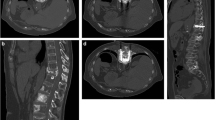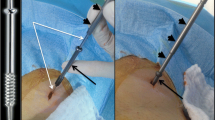Abstract
Aim
To review outcomes and local evolution of treated lesions following percutaneous image-guided screw fixation (PIGSF) of pathological/insufficiency fractures (PF/InF) and impeding fractures (ImF) in cancer patients at two tertiary centres.
Materials and methods
Thirty-two consecutive patients (mean age 67.5 years; range 33–86 years) with a range of tumours and prognoses underwent PIGSF for non/minimally displaced PF/InF and ImF. Screws were placed under CT/fluoroscopy or cone-beam CT guidance, with or without cementoplasty. Clinical outcomes were assessed using a simple 4-point scale (1 = worse; 2 = stable; 3 = improved; 4 = significantly improved). Local evolution was reviewed on most recent follow-up imaging. Technical success, complications, and overall survival were evaluated.
Results
Thirty-six lesions were treated with 74 screws mainly in the pelvis and femoral neck (58.2 %); including 47.2 % PF, 13.9 % InF, and 38.9 % ImF. Cementoplasty was performed in 63.9 % of the cases. Technical success was 91.6 %. Hospital stay was ≤3 days; 87.1 % of lesions were improved at 1-month follow-up; three major complications (early screw-impingement radiculopathy; accelerated coxarthrosis; late coxofemoral septic arthritis) and one minor complication were observed. Unfavourable local evolution at imaging occurred in 3/24 lesions (12.5 %) at mean 8.7-month follow-up, including poor consolidation (one case) and screw loosening (two cases, at least 1 symptomatic). There were no cases of secondary fractures.
Conclusions
PIGSF is feasible for a wide range of oncologic patients, offering good short-term efficacy, acceptable complication rates, and rapid recovery. Unfavourable local evolution at imaging may be relatively frequent, and requires close clinico-radiological surveillance.




Similar content being viewed by others
References
Parker C, Nilsson S, Heinrich D, Helle SI, O’Sullivan JM, Fossa SD, Chodacki A, Wiechno P, Logue J, Seke M, Widmark A, Johannessen DC, Hoskin P, Bottomley D, James ND, Solberg A, Syndikus I, Kliment J, Wedel S, Boehmer S, Dall’Oglio M, Franzen L, Coleman R, Vogel-zang NJ, O’Bryan-Tear CG, Staudacher K, Garcia-Vargas J, Shan M, Bruland OS, Sartor O, Investigators A. Alpha emitter radium-223 and survival in metastatic prostate cancer. N Engl J Med. 2013;369(3):213–23.
Coleman RE. Clinical features of metastatic bone disease and risk of skeletal morbidity. Clin Cancer Res. 2006;12:6243s–9s.
Jemal A, Siegel R, Ward E, et al. Cancer statistics, 2007. Cancer CA Cancer J Clin. 2007;57:43–66.
Perrin RG, Laxton AW. Metastatic spine disease: epidemiology, pathophysiology, and evaluation of patients. Neurosurg Clin N Am. 2004;15:365–73.
Deschamps F, Farouil G, Hakime A, Barah A, Guiu B, Teriitehau C, Auperin A, deBaere T. Cementoplasty of metastases of the proximal femur: is it a safe palliative option? J Vasc Interv Radiol. 2012;23(10):1311–6. doi:10.1016/j.jvir.2012.06.027.
Piccioli A, Spinelli MS, Maccauro G. Impending fracture: a difficult diagnosis. Injury. 2014;45(Suppl 6):S138–41.
Mirels H. Metastatic disease in long bones. A proposed scoring system for diagnosing impending pathologic fractures. Clin Orthop Relat Res. 1989;249:256–64.
Manglani HH, Marco RA, Picciolo A, Healey JH. Orthopedic emergencies in cancer patients. Semin Oncol. 2000;27:299–310.
Body JJ, Pereira J, Sleeboom H, Maniadakis N, Terpos E, Acklin YP, Finek J, Gunther O, Hechmati G, Mossman T, Costa L, Rogowski W, Nahi H, von Moos R. Health resource utilization associated with skeletal-related events: results from a retrospective European study. Eur J Health Econ. 2015.
Müller DA, Capanna R. The surgical treatment of pelvic bone metastases. Adv Orthop. 2015;2015:525363. doi:10.1155/2015/525363.
Choy WS, Kim KJ, Lee SK, Yang DS, Jeung SW, Choi HG, Park HJ. Surgical treatment of pathological fractures occurring at the proximal femur. Yonsei Med J. 2015;56(2):460–5.
Arvinius C, Parra JL, Mateo LS, Maroto RG, Borrego AF, Stern LL. Benefits of early intramedullary nailing in femoral metastases. Int Orthop. 2014;38(1):129–32.
Talbot M, Turcotte RE, Isler M, Normandin D, Iannuzzi D, Downer P. Function and health status in surgically treated bone metastases. Clin Orthop Relat Res. 2005;438:215–20.
Liu G, Hasan MY, Wong HK. Minimally invasive iliac screw fixation in treating painful metastatic lumbosacral deformity: a technique description and clinical results. Eur Spine J. 2016.
Wedin R. Surgical treatment for pathologic fracture. Acta Orthop Scand Suppl. 2001;72(302):1–29.
Deschamps F, Farouil G, Hakime A, Teriitehau C, Barah A, de Baere T. Percutaneous stabilization of impending pathological fracture of the proximal femur. Cardiovasc Intervent Radiol. 2012;35(6):1428–32.
Deschamps F, de Baere T, Hakime A, Pearson E, Farouil G, Teriitehau C, Tselikas L. Percutaneous osteosynthesis in the pelvis in cancer patients. Eur Radiol. 2015.
Garnon J, Koch G, Ramamurthy N, Caudrelier J, Rao P, Tsoumakidou G, Cazzato RL, Gangi A. Percutaneous CT and fluoroscopy-guided screw fixation of pathological fractures in the shoulder girdle: technical report of 3 cases. Cardiovasc Intervent Radiol. 2016.
Hartung MP, Tutton SM, Hohenwalter EJ, King DM, Neilson JC. Safety and efficacy of minimally invasive acetabular stabilization for periacetabular metastatic disease with thermal ablation and augmented screw fixation. J Vasc Interv Radiol. 2016.
Trumm CG, Rubenbauer B, Piltz S, Reiser MF, Hoffmann RT. Screw placement and osteoplasty under computed tomographic-fluoroscopic guidance in a case of advanced metastatic destruction of the iliosacral joint. Cardiovasc Intervent Radiol. 2011;34(Suppl 2):S288–93.
Sacks D, McClenny TE, Cardella JF, Lewis CA. Society of Interventional Radiology clinical practice guidelines. J Vasc Interv Radiol. 2003;14:S199–202.
Selvan VT, Oakley MJ, Rangan A, Al-Lami MK. Optimum configuration of cannulated hip screws for the fixation of intracapsular hip fractures: a biomechanical study. Injury. 2004;35(2):136–41.
Ye Y, Hao J, Mauffrey C, Hammerberg EM, Stahel PF, Hak DJ. Optimizing stability in femoral neck fracture fixation. Orthopedics. 2015;38(10):625–30.
Cazzato RL, Palussière J, Buy X, Denaro V, Santini D, Tonini G, Grasso RF, Zobel BB, Poretti D, Pedicini V, Balzarini L, Lanza E. Percutaneous long bone cementoplasty for palliation of malignant lesions of the limbs: a systematic review. Cardiovasc Intervent Radiol. 2015;38(6):1563–72. doi:10.1007/s00270-015-1082-7 Epub 2015 Mar 24.
Palumbo BT, Nalley C, Gaskins RB 3rd, Gutierrez S, Alexander GE III, Anijar L, Nayak A, Cheong D, Santoni BG. Biomechanical analysis of impending femoral neck fractures: the role of percutaneous cement augmentation for osteolytic lesions. Clin Biomech (Bristol, Avon). 2014;29(3):289–95.
Rüger M, Sellei RM, Stoffel M, von Rüden C. The effect of polymethyl methacrylate augmentation on the primary stability of cannulated bone screws in an anterolateral plate in osteoporotic vertebrae: a human cadaver study. Glob Spine J. 2016;6(1):46–52.
He D, Wu L, Sheng X, Xiao Q, Zhu Y, Yu W, Liu F, Zhu K. Internal fixation with percutaneous kyphoplasty compared with simple percutaneous kyphoplasty for thoracolumbar burst fractures in elderly patients: a prospective randomized controlled trial. Eur Spine J. 2013;22(10):2256–63.
Kim J-B, Park S-W, Lee Y-S, Nam T-K, Park Y-S, Kim Y-B. The effects of spinopelvic parameters and paraspinal muscle degeneration on S1 screw loosening. J Korean Neurosurg Soc. 2015;58(4):357–62.
Tian QH, He CJ, Wu CG, Li YD, Gu YF, Wang T, Xiao QP, Li MH. Comparison of percutaneous cementoplasty with and without interventional internal fixation for impending malignant pathological fracture of the proximal femur. Cardiovasc Intervent Radiol. 2016;39(1):81–9.
Cazzato RL, Buy X, Eker O, Fabre T, Palussiere J. Percutaneous long bone cementoplasty of the limbs: experience with fifty-one non-surgical patients. Eur Radiol. 2014;24(12):3059–68. doi:10.1007/s00330-014-3357-9.
Lin PP, Kang HG, Kim YI, Kim JH, Kim HS. Minimally invasive surgery for femoral neck fractures using bone cement infusible hollow-perforated screw in high-risk patients with advanced cancer. Surg Oncol. 2015;24(3):226–31.
Galbusera F, Volkheimer D, Reitmaier S, Berger-Roscher N, Kienle A, Wilke HJ. Pedicle screw loosening: a clinically relevant complication? Eur Spine J. 2015;24(5):1005–16.
Muller ME, Allgöwer M, Schneider R, et al. Manual of internal fixation: techniques recommended by the AO/ASIF group. New York: Springer; 1995.
Cazzato RL, Bonichon F, Buy X, Godbert Y, de Figuereido BH, Pointillart V, Palussière J. Over ten years of single-institution experience in percutaneous image-guided treatment of bone metastases from differentiated thyroid cancer. Eur J Surg Oncol. 2015;41(9):1247–55.
Cazzato RL, Buy X, Grasso RF, Luppi G, Faiella E, Quattrocchi CC, Pantano F, BeomonteZobel B, Tonini G, Santini D, Palussiere J. Interventional Radiologist’s perspective on the management of bone metastatic disease. Eur J Surg Oncol. 2015;41(8):967–74.
He C, Tian Q, Wu CG, Gu Y, Wang T, Li M. Feasibility of percutaneous cementoplasty combined with interventional internal fixation for impending pathologic fracture of the proximal femur. J Vasc Interv Radiol. 2014;25(7):1112–7.
Abdel-Aal AK, Underwood ES, Saddekni S. Use of cryoablation and osteoplasty reinforced with Kirschner wires in the treatment of femoral metastasis. Cardiovasc Intervent Radiol. 2012;35(5):1211–5.
Anselmetti GC, Manca A, Chiara G, Tutton S, Iussich G, Gino G, Grignani G, Ortega C, Moselli N, Regge D. Painful pathologic fracture of the humerus: percutaneous osteoplasty with bone marrow nails under hybrid computed tomography and fluoroscopic guidance. J Vasc Interv Radiol. 2011;22(7):1031–4.
Kawai N, Sato M, Iwamoto T, Tanihata H, Minamiguti H, Nakata K. Percutaneous osteoplasty with use of a cement-filled catheter for a pathologic fracture of the humerus. J Vasc Interv Radiol. 2007;18(6):805–9.
Kelekis A, Filippiadis D, Anselmetti G, Brountzos E, Mavrogenis A, Papagelopoulos P, Kelekis N, Martin JB. Percutaneous augmented peripheral osteoplasty in long bones of oncologic patients for pain reduction and prevention of impeding pathologic fracture: the rebar concept. Cardiovasc Intervent Radiol. 2016;39(1):90–6.
Kelekis A, Martin JB, Anselmetti G, Filipiadis D. Regarding, “Percutaneous augmented peripheral osteoplasty in long bones of oncologic patients for pain reduction and prevention of impeding pathologic fracture: the rebar concept”: reply. Cardiovasc Intervent Radiol. 2016;39(3):479–80.
Steensma M, Healey JH. Trends in the surgical treatment of pathologic proximal femur fractures among Musculoskeletal Tumor Society members. Clin Orthop Relat Res. 2013;471(6):2000–6.
Nawathe S, Nguyen BP, Barzanian N, Akhlaghpour H, Bouxsein ML, Keaveny TM. Cortical and trabecular load sharing in the human femoral neck. J Biomech. 2015;48(5):816–22.
Author information
Authors and Affiliations
Corresponding author
Ethics declarations
Conflict of interest
Roberto Luigi Cazzato, Guillaume Koch, Xavier Buy, Nitin Ramamurthy, Georgia Tsoumakidou, Jean Caudrelier, Vittorio Catena, Julien Garnon, Jean Palussiere and Afshin Gangi have no conflict of interest to disclose.
Ethical Approval
All procedures performed in studies involving human participants were in accordance with the ethical standards of the institutional and/or national research committee and with the 1964 Helsinki declaration and its later amendments or comparable ethical standards. For this type of study formal consent is not required.
Informed Consent
Informed consent was obtained from all individual participants included in the study.
Rights and permissions
About this article
Cite this article
Cazzato, R.L., Koch, G., Buy, X. et al. Percutaneous Image-Guided Screw Fixation of Bone Lesions in Cancer Patients: Double-Centre Analysis of Outcomes including Local Evolution of the Treated Focus. Cardiovasc Intervent Radiol 39, 1455–1463 (2016). https://doi.org/10.1007/s00270-016-1389-z
Received:
Accepted:
Published:
Issue Date:
DOI: https://doi.org/10.1007/s00270-016-1389-z




